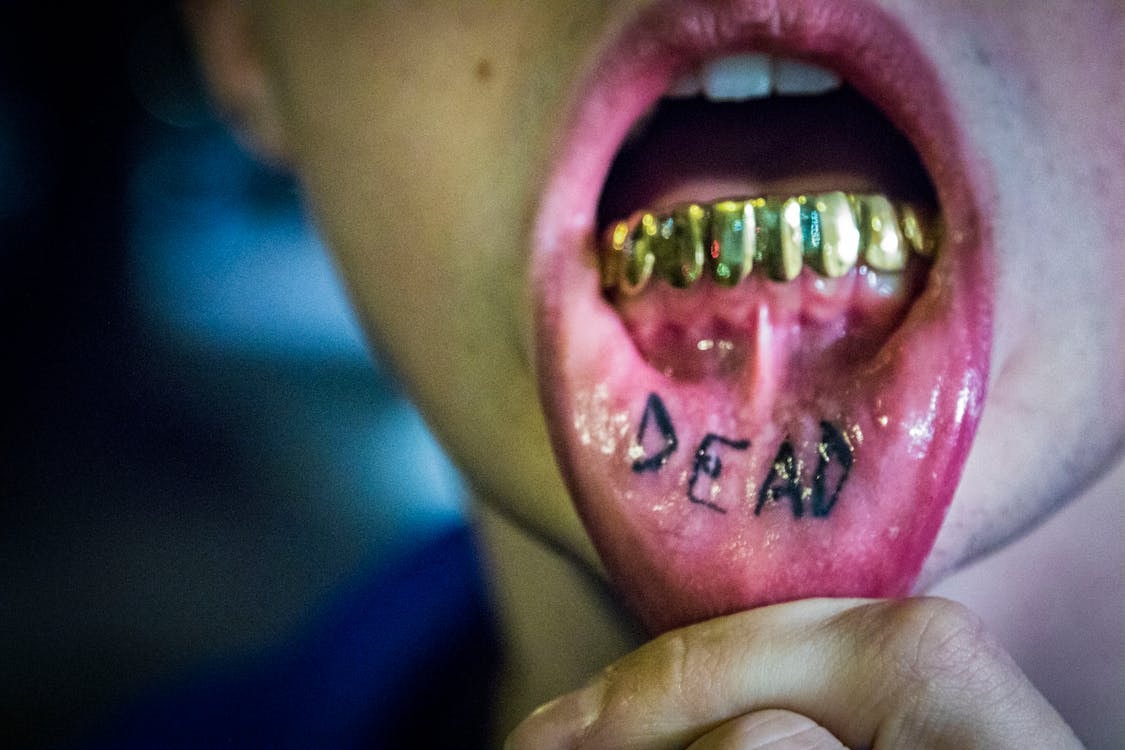Are Inside Lip Tattoos Worth the Pain?
Table of Contents

Image courtesy of Alex Alexander @ Pexels.com
We’ve all seen celebrities like Miley Cyrus and Madison Beer getting inside lip tattoos.
Yeah, they do look kind of cool and unique.
But just because Miley Cyrus jumped off a bridge, would you run out and do it too?
Now, we know that inner lip tattoos can be cool.
But if you ask us, they’re not all they’re cracked up to be.
I mean, even if you do get one, nobody is going to be able to see it unless you turn your inner lip out to show them.
And what’s the point of that?
So are inside lip tattoos really worth the pain?
Below, we’re diving into all the ins and outs of lip tattoos, and why you might not want to get one after all.
What Are Some Pros And Cons Of An Inner Lip Tattoo?
If you’re reading this, you’re obviously considering getting an inner lip tattoo.
So to help you decide whether or not it’s worth the pain, take a moment to consider the following pros and cons.
The pros of inner lip tattoos
Unique – Not very many people have inner lip tattoos, so if you do get one you’ll be able to say that you indeed do have a very unique tattoo.
Hidden – If you’re trying to be discreet, an inner lip tattoo is great because nobody will see unless you show them.
Party tricks – If you like being the life of the party, you’re certain to be the center of attention when you flip your bottom lip inside out to show off your new ink.
Quick healing time – Inner lip tattoos are generally healed within a week or two.

Image courtesy of cottonbro studio @ Pexels.com
The cons of inner lip tattoos
Painful – Your lips are very sensitives and getting them tattooed is going to hurt a lot! Check out our tattoo pain chart to learn more!
Healing process – Inner lip tattoo aftercare is tricky and you’ll need to avoid any type of irritation. Otherwise, you risk infection and just a poor healing process.
They don’t last – Because your mouth is constantly renewing its skin cells, your inner lip tattoo is likely to fade quickly.
Artist refusal – Because they fade fast, many artists won’t even offer to give your an inner lip tattoo.
Swelling – Especially right after you get your lip tattooed, it’s going to be swollen for a couple of hours. This should subside on its own, but don’t plan on going on any dates or taking nice pictures right after your tattoo session.
Hidden – Yes, this is both a pro and a con… It’s a positive thing if you’re trying to hide your new tattoo from your mom or your boss. But you also won’t be able to show off your tattoo like you would be able to with an arm tattoo.
Obviously, these are just some of the pros and cons of getting an inner lip tattoo.
But if you ask us, the biggest problem with these types of tattoos is that they simply don’t last very long.
How Long Do Inner Lip Tattoos Last?
An inner lip tattoo can last anywhere from just a few weeks to a few months, or even a few years or longer.
It all depends on how well the tattoo was done, how well you take care of it while it’s healing, and a number of other factors like your own physical health.
For starters, because it’s inside your mouth, the healing process for an inner lip tattoo is a bit trickier than tattoos on the rest of your body.
Even just eating certain foods can slow down healing times or make it impossible for the ink to completely heal.
Secondly, it’s the fact that the skin cells in your mouth have a much higher turnover rate than skin cells anywhere else on your body.
This means that your mouth heals quickly and is constantly regenerating itself, producing new skin cells and shedding old one, some of which will contain the tattoo ink that you’re hoping to keep in there.
So even if your lip tattoo is done properly, there’s a good chance it will fade fairly quick.
Image courtesy of Bermix Studio @ Unsplash.com
Inside Lip Tattoo Aftercare Tips
Just like getting a tattoo on any other part of your body, you’ll need to take very good care of your lip tattoo if you want it to last forever.
Let’s take a look at a handful of important inner lip tattoo aftercare tips.
Alcohol free mouthwash – Mouthwash is vital for keeping your mouth clean and free from bacteria while your lip tattoo heals. And trust me, you’ll want to use alcohol-free mouthwash, which is a lot more gently and won’t burn.
No alcohol – Similarly, alcohol is to be avoided until your new lip tattoo is completely healed. The good news is that inner lip tattoos heal faster than tattoos elsewhere on your body. So you’ll be able to drink soon, just not yet! Learn more about when can I drink after getting a tattoo?
Avoid acidic foods – Spicy foods won’t only sting or burn your newly tattooed lip. They can also irritate the thin skin around your fresh tattoo, which can be uncomfortable and can cause the ink to fade prematurely.
No smoking – Smoking is another big no-no because it can irritate the tattoo on your lip and slow down the healing process.
Don’t touch it – You’re tongue is probably going to want to wander and poke around at your new ink, but do your best to avoid it. And definitely don’t stick your fingers in your mouth to touch it, which could introduce harmful bacteria into the tattoo.
Brush gently – You can and should still brush your teeth, but be sure to be gentle and try not to touch the tattooed area any more than you might need to.
No kissing – Kissing won’t only be uncomfortable with a newly tattooed lip, it can also introduce bacteria into your mouth, which can lead to infection.
Avoid hot foods – Here we mean hot, like ha-ha-ha-hot food, not spicy foods. Hot food can literally burn your mouth and your new tattoo, which will also mess with and slow down the healing process.
Lip Tattoos As Permanent Makeup
Although some of you might want a word or simple tattoo design on your lip, there are other more cosmetic reasons to get your lips tattooed.
For example, some might want to get lip tattoos to change the color of their lips, adding more of a blush effect.
And while getting this type of tattoo is going to hurt, it will save you a lot of money on lipstick.
Image courtesy of Kaja Reichardt @ Unsplash.com
Why You Shouldn’t Get A Lower Lip Tattoo
Honestly, we don’t really ca
re if you get a lower lip tattoo or not.
In fact, all the more power to you if you do go through with it (we’re talking to you, Miley Cyrus).
But because these tattoos generally don’t last very long, we don’t really recommend getting one, unless of course you’re running out of places on your body to get inked.
Now, let’s review some of the reasons why we don’t believe inner lip tattoos are worth the pain.
Painful – Yes, all tattoos are painful. But your mouth has extremely thin and sensitive skin inside of it. And many have said that inner lips tattoos are very painful with little reward since nobody will even be able to see it.
They fade faster – Because the skin in your mouth has a rapid cell turnover, inner lips tattoos tend to fade much faster than other tattoos. Some inner lip tattoos can last 5 years or longer, but many will begin to fade within a few months.
Limited designs – Unless you have a huge mouth, you’ll be limited to simple designs and words, and absolutely no cool, abstract designs.
Hard to find an artist – Because they fade fast and people are often disappointed in that, many tattoo artists won’t even agree to give you an inner lip tattoo. So if you can find a willing artist, good for you! Otherwise, good luck finding one!
Infection risk – Just like any other tattoo, mouth tattoos can become infected, which is never something you want going on inside your mouth. An infected mouth tattoo can make it hard to eat or drink until the infection clears up and heals.
Nobody will see it – Isn’t half the fun of getting a cool tattoo that other people will see it and think you’re cool too? Well unless you pull out your lip to show them, nobody will be able to see your inner lip tattoo.
Scarring – If anything goes wrong and you end up with an infection or worse, you could end up with some nasty scarring inside your mouth. Sure, nobody will see the thing. But a big ugly scar is certainly not something I’d want inside my mouth.
All that said, it’s completely your choice if you do want to get an inner lip tattoo.
We just want to say that we’ve warned you and in our humble opinion, they’re not worth the pain!
Can I get my gums tattooed?
While it’s theoretically possible to tattoo your gums, we don’t think you want to do it. In some African cultures, gum tattoos are relatively common. But because of the health risks involved, it’s not something many tattoo artists are willing to do in the Western World.
How long does it take for an inner lip tattoo to heal?
Because of the rapid skin cell turnover rate inside your mouth, inner lip tattoos generally heal within one or two weeks. That said, you still need to follow your artist’s aftercare instructions, and avoid irritating your new tattoo at all costs.
Ready to test out some different lip tattoo designs? Check out our innovative AI tattoo generator today!

